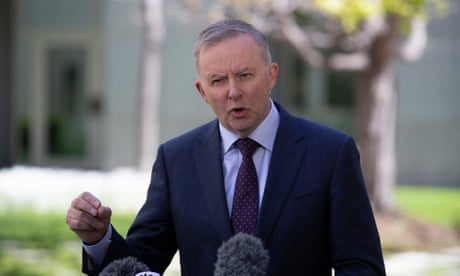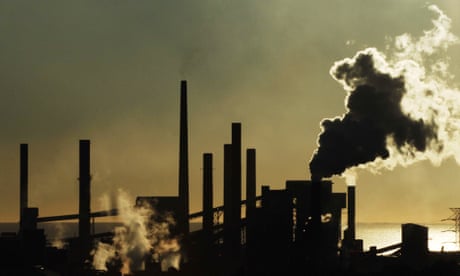Extract from The Guardian
With parts of the business community ready to move on emissions, the opposition’s modest goal could be easily met – or surpassed.

Anthony Albanese says the Labor party’s climate policy will create jobs and cut power bills, while boosting renewable energy.
Last modified on Sat 4 Dec 2021 09.03 AEDT
Labor’s new climate policy, released on Friday afternoon at the very end of the parliamentary year, is impossible to assess without holding it up against 12-plus years of broken Australian climate politics – but let’s give it a try.
Yes, Labor has lost a string of elections at which it promised to do more than the Coalition on climate and was rewarded with lies and misinformation. Attention will probably quickly turn to whether the opposition’s plan for 2022 is electorally viable. Fair enough.
But we should start at first principles: is the policy – called Powering Australia – up to the task of addressing the climate crisis? And could it set up Australia to thrive in a future that no longer relies on fossil fuels?
At first blush, the short answers are (1) no, not on this alone and (2) possibly.
Anthony Albanese’s plan is aimed at hitting a 2030 emissions target while expanding industries that could ultimately deliver net zero emissions by 2050. Unlike the Coalition, it does not pretend to map a path to hitting that goal mid-century.
The headline emissions goal – a 43% cut by 2030 compared with the 2005 levels – will be described by some as a stretch, and was quickly attacked by Scott Morrison as bad news for coal regions and manufacturing. But the plan tells a different story.
In reality, it’s a modest goal when measured against what would happen anyway, while still being more ambitious than the Coalition’s “technology will save us” approach. Which, of course, is the point.

It falls well short of what scientists have found Australia should be doing if the world is to limit global heating to 2C above pre-industrial levels, let alone the 1.5C goal backed by more than 190 countries in the recent Glasgow climate pact.
Several studies have suggested Australia should be making at least a 50% reduction this decade, and almost certainly substantially more, to play its part in tackling the crisis. ClimateWorks Australia found rapid, deep cuts can be achieved using technology that is mature and available.
Albanese and his climate change spokesperson, Chris Bowen, emphasised their plan was built on official government projections that the country will make at least a 30% cut even without introducing any new policies. Separate assessments have found state government action – particularly in the biggest states, New South Wales and Victoria – are likely to lift that to somewhere in the mid-to-high 30s if delivered as promised.
It tells us that, even before we get into the details, Labor’s goal is more than achievable, and should be seen as a floor to what’s possible.
Albanese’s central claim is that the policy will create jobs – it estimates 64,000 direct and 540,000 indirect – and cut power bills while boosting renewable energy.
The central driver is a previously announced off-budget $20bn “re-wiring the nation corporation” charged with upgrading the electricity grid. Bringing forward planned new transmission links is meant to allow a faster influx of large-scale solar, wind and batteries in regional renewable energy zones. It is also committing $300m to developing community batteries and shared “solar banks” for households and businesses who can not put panels on their roofs.
Implausibly, Labor’s plan claims the accelerated rollout of renewable energy will not lead to the early closure of ageing coal-fired power plants, despite experts having already forecast that some could shut earlier than scheduled. The idea that coal power and its jobs will continue when its electricity is no longer needed is remarkably hard to shake in Canberra, if not elsewhere.
The biggest new element on Friday – or revamped old element, given it was part of Labor’s abandoned 2019 policy – is that Albanese and Bowen plan to use the Coalition’s safeguard mechanism to cut emissions at big industrial sites.
The safeguard mechanism was introduced under Tony Abbott with a promise it would put a limit on industrial emissions. In practice, it has failed – companies have consistently been allowed to increase their carbon pollution without penalty, and industrial emissions are up 17% since 2005 and 7% since the safeguard began in 2016. Both industry representatives and climate activists believe it has made the scheme a waste of time.
Greg Hunt, the scheme’s architect when environment minister, planned for emissions limits under the safeguard to eventually tighten, but the Coalition ultimately rejected forcing companies to take action. Labor is now promising to do what Hunt always intended by working with business to cut industrial greenhouse gases by 5m tonnes – about 1% of Australia’s total emissions – a year from 2023.
Combined with direct funding from business from a new $15bn national reconstruction fund, which would provide low-cost financing to industry to embrace clean solutions, the modelling suggests this will cut emissions by up to 48m tonnes a year by 2030. Bowen said on Friday he expected about 50% of the cuts through the safeguard to come through use of improved technology, the rest from companies paying for carbon offsets.
Labor has some political cover here. It is not only using an existing Coalition policy, but has adopted a model released by the Business Council of Australia in October. The government was quick to attack it anyway, describing it as a “sneaky new carbon tax”.

Instead, Labor is focusing on tax breaks for low-emissions cars. Along with the rollout of charging infrastructure, the modelling suggests this will help lead to 89% of new car sales and 15% of all vehicles being EVs by 2030.
These policies add up to a promise of a smaller cut in emissions by 2030 than Labor was promising under Bill Shorten less than three years ago, when its target was a 45% reduction.
From one perspective, this is remarkable, given the global urgency for action has only increased in the past two years. From another, Labor has made a more ambitious emissions pledge than many expected, given the internal concern about another News Corp-backed scare campaign.
Asked on Friday for his response to those who say his policy falls short of what climate science demands, Albanese argued the new target was roughly the same as Canada’s – another fossil fuel economy – and suggested the ALP had acted responsibly by first designing its policies and then paying for independent modelling to calculate what they would deliver.
Few would argue it is how you would design a climate policy if starting from scratch.
What is routinely described as the most efficient way ahead – a well-designed carbon price – remains off-the-table since the Coalition repealed a functioning scheme in 2014. And there is no commitment to cut fossil fuel subsidies or curb the government-funded expansion of the gas industry.
Perhaps the major thing in Labor’s favour if it wins next year’s election is that significant parts of the business and investment community are now ready to move in a way they haven’t been before. People may be surprised how quickly a 43% emissions reduction target could be met, or surpassed, under a government more inclined to back that push.
No comments:
Post a Comment